
 |
California's Tax SystemA PrimerChapter 2 |
Taxes are levied based on the filing status of the taxpayer. California has five filing statuses: single, married filing a separate return, married filing a joint return, surviving spouse, and head of household. There are six tax brackets for each filing status, with marginal tax rates ranging from 1 percent to 9.3 percent, depending on a taxpayer's income level.
| California Tax Schedule for Married Couples Filing Joint Returns | |||||
| 2000 Tax Year | |||||
| If Taxable Income is: | Computed Tax Is: | ||||
| Over | But Not Over | Base Amount | Plus | Of Amount Over | |
| $0 | $10,908 | $0 | 1.0% | $0 | |
| 10,908 | 25,852 | 110 | 2.0 | 10,908 | |
| 25,852 | 40,802 | 408 | 4.0 | 25,852 | |
| 40,802 | 56,642 | 1,006 | 6.0 | 40,802 | |
| 56,642 | 71,584 | 1,956 | 8.0 | 56,642 | |
| 71,584 | -- | 3,152 | 9.3 | 71,584 | |
The PIT's key features include:
The computation of California PIT liabilities is based on federal adjusted gross income (AGI). In turn, federal AGI equals total income from all sources less exempt or excluded income, plus certain federal adjustments. California generally conforms to federal PIT law except in specific circumstances. The procedure for calculating California's PIT is shown in the accompanying figure.
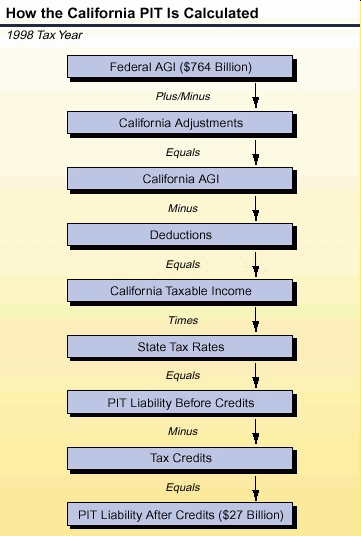
California's PIT is a progressive tax, meaning that the "last" dollar of income earned is subject to increasingly higher marginal tax rates as income increases. As a result, the share of one's income paid in taxes generally rises with income. Put another way, the average tax rate rises with income, causing taxpayers with higher taxable incomes to pay a proportionately larger share of their income in taxes than those with lower incomes. For example, a married couple filing jointly with two dependents and taking the standard deduction would have an effective tax rate of 1.4 percent based on an income of $50,000, versus an effective rate of 4.8 percent based on a $100,000 income.
In 1998:
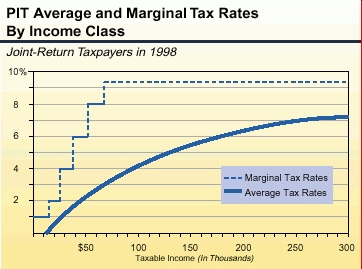
Of the different types of income subject to the PIT, wages and salaries constitute by far the largest portion. In 1998:
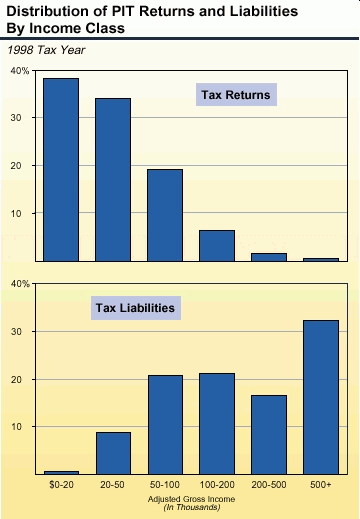
Although wages and salaries continue to account for the majority of PIT revenues, the share attributable to capital gains has increased quite dramatically in recent years.
The growing importance of capital gains in generating PIT revenues reflects two main factors.
The increased role of capital gains also has brought with it certain revenue-related challenges. Most important, it has made the PIT inherently more volatile and difficult to forecast than previously. This is because capital gains themselves are highly variable, due to (1) their dependency on the volatile stock market and housing sectors and (2) the fact that most stock-related capital gains are not taxed in the year of accrual and can remain unrealized for many years.
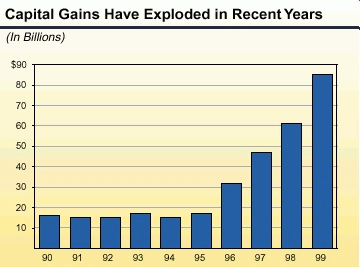
A PIT is imposed by 43 states and the District of Columbia. The PIT-related interstate comparisons of greatest interest involve its overall tax burden and its relative marginal tax rates. With regard to the former, the state's overall PIT tax burden--as measured by tax liabilities per $100 of personal income in 1998-99--is $3.74 (see following figure). This is above the average of both all other states ($2.21) and other western and industrial states ($2.81 and $2.95, respectively).
The latter issue of marginal tax rates is of special interest because high-marginal rates may in some situations result in discouraging work. California's highest-marginal rate of 9.3 percent is above that of most other states. Its lowest-marginal tax rate, however, is lower and covers a larger amount of income than in many other states. Of course, the fact that California's total burden for all taxes combined is about average means that its higher PIT burden is offset by a lower combined burden for its other taxes.
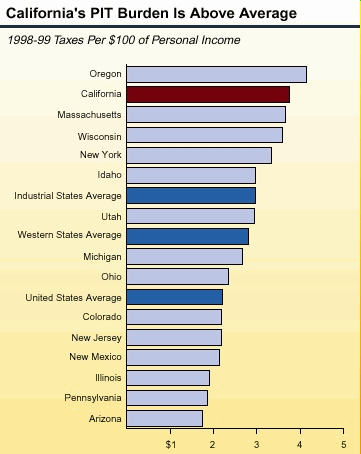
Some key PIT-related policy issues facing policymakers include:
| Comparison of PIT Marginal Tax Rates | ||||
| Single Taxpayers, 1999 | ||||
| State | Starting Marginal Tax Rate |
Applies to Taxable Income Up To | Top Marginal Tax Rate |
Applies to Taxable Income Beginning |
| California | 1.00% | $5,264 | 9.30% | $34,548 |
| Oregon | 5.00 | 2,350 | 9.00 | 5,850 |
| New Mexico | 1.70 | 5,500 | 8.20 | 65,000 |
| Idaho | 2.00 | 1,000 | 8.20 | 20,000 |
| Ohio | 0.74 | 5,000 | 7.50 | 200,000 |
| New York | 4.00 | 8,000 | 6.85 | 20,000 |
| Wisconsin | 4.77 | 7,620 | 6.77 | 15,240 |
| New Jersey | 1.40 | 20,000 | 6.37 | 75,000 |
| Massachusetts | 5.95 | all | 5.95 | all |
| Arizona | 2.87 | 10,000 | 5.04 | 150,000 |
| Colorado | 4.75 | all | 4.75 | all |
| Michigan | 4.40 | all | 4.40 | all |
| Illinois | 3.00 | all | 3.00 | all |
| Pennsylvania | 2.80 | all | 2.80 | all |
Return to California's Tax System--A Primer Table of Contents